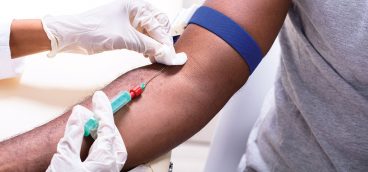Is Sitting the New Smoking?

The headlines have been frightening. CNN says, “Sitting for hours can shave years off life.” Men’s Health magazine declared in bold type, “Why your desk job is slowly killing you.”
Google “sitting disease” and the first link is juststand.org, where anyone can download a free “info graphic” featuring a skeleton typing away at a desk.
Sitting disease is getting much publicity lately—and for good reason. The scientific evidence is mounting that being idle for long stretches, day in and day out, may be the root of our nation’s poor state of health, contributing to not only back pain and obesity but type 2 diabetes, heart disease and even certain types of colon and other cancers.
It’s important to keep in mind that in many ways the verdict is still out on whether we really are sitting ourselves to death. Lots of data confirm that smoking causes cancer and a slew of other health problems. The research on prolonged periods of inactivity, on the other hand, mostly shows an association with ill health. The distinction has caused some commentators to declare the sitting issue another oversimplification of healthcare research overhyped by the media.
Although headlines are meant to draw in readers (and the juststand.org website is backed by Ergotron, a company that sells office furniture designed to get us out of our chairs), there is valid research showing that the human body functions best when it stays in motion. And some who are studying our idle ways are blunt about its ill effects.
“Excessive sitting is a lethal activity,” said Mayo Clinic endocrinologist Dr. James A. Levine in a recent New York Times article. Levine is a leading inactivity researcher, the the author of “Move a Little, Lose a Lot,” and he’s credited for coming up with the idea of the “treadmill desk.”
With our workplaces and schools filled with desks and chairs, many Americans sit more than nine hours a day.
Sitters tend to die sooner
Sitting disease is the popular term that has evolved from the relatively new research field known as inactivity physiology, coined by Marc T. Hamilton, now of the Pennington Biomedical Research Center of Baton Rouge, La. More than a decade ago, he and his research team found “surprisingly potent and rapid direct effects caused by reducing light activity” in a single day. First, they saw this in lab animals and later in people.
“Not only are our own experimental lab studies continuing to show that the effects of inactivity, and light activity, are more important for health than we had originally expected, but also dozens of observational (epidemiological) studies are providing a high level of consistent agreement,” Hamilton says.
One recent study that has generated much attention was done by a researcher at the American Cancer Society. After tracking the health of 123,000 Americans over a 14-year period, he found that women who sat for 6-plus hours a day were 40 percent more likely to die within the study period, compared with women who sat for less than 3 hours a day. For men, the difference was 20 percent. And for both genders, it didn’t matter if they exercised or not.
Molecular mayhem of muscles at rest
As soon as we sit, Hamilton explains, electrical activity in our leg muscles stops, impacting a variety of metabolic pathways influencing heart disease and diabetes. For example, an enzyme that acts like the vacuum cleaner for blood fat is shut off, leading to other effects on cholesterol metabolism.
What researchers also are finding is that the ill effects of sitting most of the day can’t be undone with a gym workout. “Even if people meet the current recommendation of 30 minutes of physical activity on most days each week, there may be significant adverse metabolic and health effects from prolonged sitting,” concluded the authors of a 2009 editorial in the British Journal of Sports Medicine.
“It is time to consider excessive sitting a serious health hazard, with the potential for ultimately giving consideration to the inclusion of too much sitting (or too few breaks from sitting) in physical activity and health guidelines,” Hamilton and colleagues wrote in the journal Current Cardiovascular Risk Reports.
Amidst all of this dire news, Hamilton said that people need hope and practical ways to counter the ill effects of prolonged idleness. More exact recommendations will be forthcoming, he says, based on “dose-response studies my lab is doing so that we’ll be able to tell people what works and what is a waste of time.”
Just walk away
In the meantime, we can look at those water or coffee breaks we take throughout the day, the dishes we put away or the umpteenth Lego we pick up (for those of us with young boys at home) as possibly the secret to a longer, healthier life. “Any type of brief, yet frequent, muscular contraction throughout the day may be necessary to short-circuit unhealthy molecular signals causing metabolic diseases,” Hamilton says.
While scientists today have more sophisticated ways to measure the effects of idleness, it’s not a new topic of study. In a British study published in the 1950s, researchers discovered that double-decker bus drivers, who spent most of their day sitting, were almost twice as likely to die of heart disease compared with the bus conductors who worked on their feet.
It’s also not new that the media has been trying to scare us out of our sluggish ways. “We May Be Sitting Ourselves to Death” was a headline in November 1961 in The Atlantic magazine. Kennedy was president and had just issued another call to the nation “to become alarmed about and to take some action to correct the apparently poor state of physical well-being in this country.”
The article continued: “There is a note of urgency behind this latest call for action to build physical fitness.”
More recently, Hamilton gave a similar warning in the journal Diabetes, “the dire concern for the future may rest with growing numbers of people unaware of the potential insidious dangers of sitting too much and who are not taking advantage of the benefits of maintaining non-exercise activity throughout much of the day.”
Time will tell whether the warnings from researchers and the media prove to be true—and whether Americans will finally heed them.
Read more at roomfordebate.blogs.nytimes.com (“Is all that sitting really killing us?”), where a University of Pittsburgh School of Law student weighs in on a “standing desk” and debates whether our sitting-prone society is shortening life spans.




